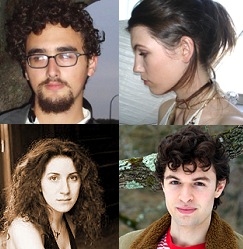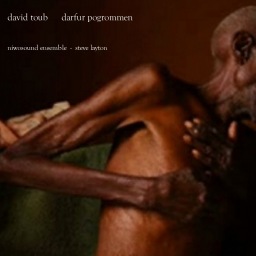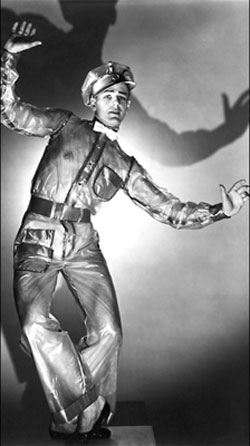I.
Early in our conversation yesterday, Hilary Hahn, loquacious and genial throughout, was chatting openly about music and athleticism; about how half her practice time was geared towards staying in shape; how solo recitals were more physically draining than chamber and concerto performances; how different halls, players, even A’s demanded great flexibility; and how flexibility and one’s ear were integral to the athleticism she strove to maintain. I commented on how some pieces were meant just to be big flashy fluffs, and that this was fine; have fun, play fast, show ’em you can hit those notes – not everything’s supposed to be late Brahms. But this, she replied, was not how she saw things. All the music she plays, she believes in entirely; were she to suspect a piece of superficiality, she would not play it; practice time is precious and is for profound music alone.
 II.
II.
This April, Hilary Hahn (via Deutsche Grammophon) brings us that feste Burg of twelve-tone serialism, the Schoenberg violin concerto. Hahn’s been wanting to record the piece for years. First she needed to book some performances to force herself to learn the (very difficult) piece. Though no orchestras she contacted had actually played it, she was able to muscle enough of them into agreeing to the project that she could let her interpretation grow on the concert stage for a few years before entering the recording studio. She decided to pair the Schoenberg with the Sibelius violin concerto, and Esa-Pekka Salonen (naturally) conducts. The two concertos show off one another very, very well. The Schoenberg’s tense chromatic saturation finds release in the expansive diatonic washes of the Sibelius. Hahn sees the project as an attempt to release each concerto from narrow pre-conceptions: the Schoenberg is really more Romantic than academic, and the Sibelius is more international than Finnish.
III.
Hahn was born in Virginia, but home, as one suspects and as she frankly admits, is on the road. She enjoys the non-stop traveling and hotel stays. Her life, she claims, is simpler when touring than when staying put. While on tour, she keeps an online journal, in which recently she’s been pretty active. (She once considered doing a creative writing MFA.) Her journal is intended for anyone who might come across it, she says, but young people considering a musical career are her primary audience. Having been blessed with good connections in the local music community as a kid, she wants those who aren’t so lucky to feel connected to what actually happens when concerts are made. She wants kids to realize international music stars go through many of the same aches and pains as everyone else. Currently concertizing in Switzerland, before the end of the spring Hahn will be back in the States playing, among other programs, some concerts with Josh Ritter. She is taking the summer off to row.
 And you thought all those novel techniques came from post-1950s Euro-modernists?:
And you thought all those novel techniques came from post-1950s Euro-modernists?: New Yawkers could do worse at 8 p.m. on March 1st, than drop by
New Yawkers could do worse at 8 p.m. on March 1st, than drop by  The
The  Alex Ross has a splendid piece titled
Alex Ross has a splendid piece titled 
 Growing up in a podunk, nil-culture, border-ish town in Washington State, half of my classical education came by way of drifty, static-filled, late-night AM listening to the CBC. Not only work by Stravinsky, Boulez, and Xenakis, but a whole raft of amazingly strong Canadian composers: R. Murray Schafer, John Rea, Claude Vivier and the like. Many of these recordings were CBC productions, and were something that gave me an early admiration of our northern neighbor’s commitment to the arts.
Growing up in a podunk, nil-culture, border-ish town in Washington State, half of my classical education came by way of drifty, static-filled, late-night AM listening to the CBC. Not only work by Stravinsky, Boulez, and Xenakis, but a whole raft of amazingly strong Canadian composers: R. Murray Schafer, John Rea, Claude Vivier and the like. Many of these recordings were CBC productions, and were something that gave me an early admiration of our northern neighbor’s commitment to the arts. Dance is always about music, and music is, more often than not, about dance. But how does dance animate music, and music animate dance? This seemed to be the central question when I caught Program 1 of the San Francisco Ballet’s 75th anniversary season at the War Memorial Opera House February 9th. Classical ballet and modern dance sometimes plays against and even ignores the music’s rhythmic structure which would never happen in the deservedly popular Dancing With The Stars. But we rightly or wrongly cut the highbrow forms a bit more slack.
Dance is always about music, and music is, more often than not, about dance. But how does dance animate music, and music animate dance? This seemed to be the central question when I caught Program 1 of the San Francisco Ballet’s 75th anniversary season at the War Memorial Opera House February 9th. Classical ballet and modern dance sometimes plays against and even ignores the music’s rhythmic structure which would never happen in the deservedly popular Dancing With The Stars. But we rightly or wrongly cut the highbrow forms a bit more slack.